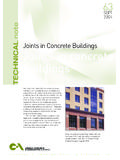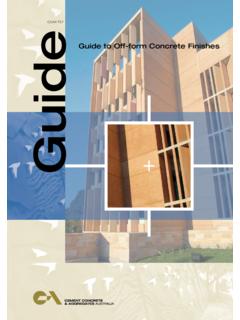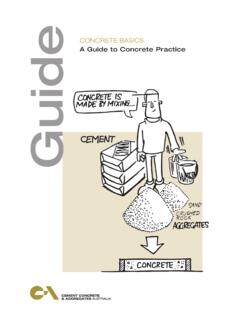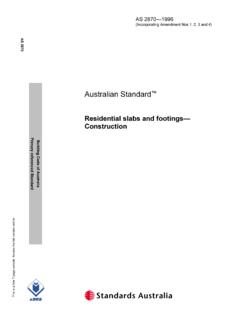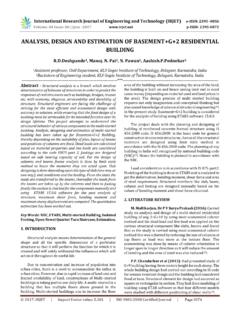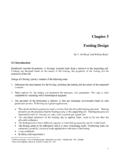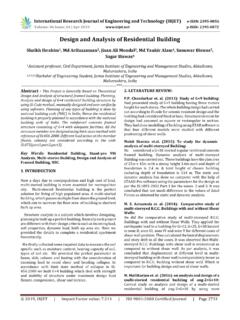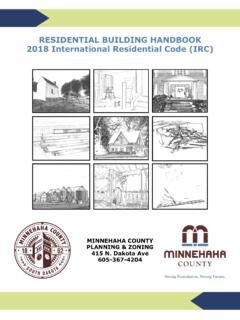Transcription of Guide to Residential Floors Guide
1 Guide to Residential FloorsGuideCCAA T49-2003 First published 1998 Second edition April 2003 CCAA T49 Cement Concrete & Aggregates Australia 2003 Except where the Copyright Act allows otherwise, nopart of this publication may be reproduced, stored in aretrieval system in any form or transmitted by anymeans without prior permission in writing from theCement Concrete & Aggregates information provided in this publication is intendedfor general guidance only and in no way replaces theservices of professional consultants on particularprojects. No liability can therefore be accepted by theCement Concrete & Aggregates Australia for its AND LAYOUTH2O creative communicationILLUSTRATIONTechMedia Publishing Pty LtdISBN 1-877023-07-8 Guide to Residential FloorsGuideCement Concrete & Aggregates Australia is a not-for-profit organisation established in 1928 and committedto serving the Australian construction Association is acknowledged nationally andinternationally as Australia s foremost cement andconcrete information body taking a leading role ineducation and training, research and development,technical information and advisory services, and being asignificant contributor to the preparation of Codes andStandards affecting building and building Association s principle aims are to protect andextend the uses of cement.
2 Concrete and cement-based products by advancing knowledge, skill andprofessionalism in Australian concrete construction andby promoting continual awareness of products, theirenergy-efficient properties and their uses, and of thecontribution the industry makes towards a Concrete & Aggregates AustraliaABN 34 000 020 486 SYDNEY OFFICE:Level 6, 504 Pacific HighwaySt Leonards NSW Australia 2065 POSTAL ADDRESS:Locked Bag 2010St Leonards NSW 1590 TELEPHONE:(61 2) 9437 9711 FACSIMILE:(61 2) 9437 9470 BRISBANE OFFICE: Level 14, IBM Building 348 Edward Street Brisbane QLD 4000 TELEPHONE:(61 7) 3831 3288 FACSIMILE:(61 7) 3839 6005 MELBOURNE OFFICE:2nd Floor, 1 Hobson Street South Yarra VIC 3141 TELEPHONE:(61 3) 9825 0200 FACSIMILE:(61 3) 9825 0222 PERTH OFFICE:45 Ventnor Avenue West Perth WA 6005 TELEPHONE:(61 8) 9389 4452 FACSIMILE:(61 8) 9389 4451 ADELAIDE OFFICE:Greenhill Executive Suites 213 Greenhill RoadEastwood SA 5063 POSTAL ADDRESS:PO Box 229 Fullarton SA 5063 TELEPHONE:(61 8) 8274 3758 FACSIMILE:(61 8) 8373 7210 Extractive Industries Office: PO Box 243 Henley Beach SA 5022 TELEPHONE:(61 8) 8353 8151 FACSIMILE:(61 8) 8353 8151 TASMANIAN OFFICE:Extractive Industries Office: PO Box 246 Sheffield TAS 7306 TELEPHONE:(61 3) 6491 2529 FACSIMILE:(61 3) 6491 first released in 1998, this publication coveredslab-on-ground Floors in detail but contained only alimited outline of the alternatives available forsuspended Floors .
3 Comprehensive information on thelatter was at that time provided in the Association scompanion publication Guide to Suspended ConcreteFloors for Houses(T40) published in earlier publications are now superseded by thissecond edition of Residential Floors . It covers bothslab-on-ground and suspended Floors in similar detail tothat found in its predecessors. The content has beencompletely updated to reflect changes in statutoryrequirements, site practices and available target audience is building designers, architectsand engineers. However, the general information onboth slab-on-ground and suspended Floors is presentedin such a way as to give building owners and owner-builders an understanding of what is involved, enablingthem to participate in the selection permission of the National Precast ConcreteAssociation Australia (NPCAA) to use material from itsPrecast Concrete Handbookin the preparation ofSections is gratefully Definitions2 Scope3 Responsibility for Design4 Slab-on-ground The Function of Footing Slab Construction Issues and Maintenance5 Suspended Types of Suspended Terminology and design design Insitu Composite Concrete/Steel (Permanent Steel Formwork)
4 Precast Concrete Composite Flooring Composite Flooring Beam and Precast Solid Autoclaved Aerated Concrete (ACC)6 References and Further Further ReadingAppendix 1 Procedure for Using a Concrete Slab on GroundConstructed in Accordance with AS as Part ofthe Termite BarrierContents offers the flexibility of a structural material thatcan be cast into almost any desired shape and size ormade in a factory in predetermined sizes. Concreteconstruction can respond to the many specificrequirements and design considerations found inmodern than 80% of housing incorporates concreteflooring of one type or another; either in slab-on-groundfloors/ footings or in suspended Floors . The reasons forchoosing a concrete flooring system are many andvaried and will differ from one project to the next.
5 Someof the advantages concrete flooring offers are:Durability a properly constructed concrete floorwill outlast most of the other components of concrete Floors designed to carry theimposed loading will generally possess adequatestiffness and will not deflect under the appliedload so as to create problems in non-structuralelements, eg efficiency concrete Floors possess highthermal mass and this can be used to improvethe internal environment within the dwelling andreduce the energy demand for thermal performance concrete Floors can meetthe acoustic performance requirements set out inthe Building Code of Australia (BCA) of construction concrete Floors can beconstructed quickly. The adoption of concretefloor/ footings speeds the completion of theground floor. Precast flooring systems have theadded advantage of reducing the amount oflabour required on slab-on-ground floor/ footings also provide apleasing transition between indoor and outdoor livingareas, a very important consideration in Australia's vasttemperate regions.
6 The change of level is minimal,making for easy negotiation by the very young and theelderly alike. Further, with the design flexibility inherent inthe system and construction methods, a sloping site isnot a deterrent. One of the options on such a site is touse a cut-and-fill approach and deepen the perimeterbeams to economically retain the terms footing and foundation are used variouslywithin the technical literature to refer to something thatsupports a building. In this Guide the terms have themeaning ascribed to them in AS 28702, as shownbelow. Foundations can be either stable or reactivedepending on the soil properties, and a footing can beanything from a strip footing through to a waffle fillMaterial that has been placed andcompacted in layers by compaction equipment within adefined moisture range to a defined density requirementin accordance with Clause (a) of AS 2870 and fillMaterial compacted in layers by repeatedrolling with an excavator in accordance with (b) of AS fillFill other than the aboveFill depthFor a slab, depth of fill is measured from the undersideof the slab panel to the natural surface level orexcavated surface in natural material.
7 For a strip or slabfooting system, the depth of fill is measured from thefinished ground level to the natural surface construction that transfers the load from thebuilding to the foundation, eg supporting ground that supports the survey A survey, undertaken by geotechnical engineers (or ageologist in some States), to determine the soil profileof a building site. It establishes soil type, moisturecontent, bearing capacity and possible reactivity of soilwhen subjected to the climatic conditions likely to beencountered at the site, thus enabling the siteclassification to be made. The resulting report enablesappropriate footing and slab details to be designed thatcomply with the requirements of AS and pilesA structural member that is driven, screwed, jacked,vibrated, drilled or otherwise installed in the ground soas to transmit loads to the soil or rock.
8 Note: Drivenpiles may be a problem in urban areas with vibrationaffecting adjoining by auguring the foundation soil to forma cylinder and filling with concrete (an economicalmethod of providing adequate founding and bearingcapacity for footings and slabs constructed on filledsites, unstable or suspect soils or to attain bridging fordistribution of loads over underground services).DrivenFormed by driving a concrete, steel or treatedtimber section into the ground to a specific depth oruntil a certain level of resistance is concreteLocally deepened sections of thefooting trenches into natural or acceptable foundation 1 Introduction3into which concrete is poured to provide adequatebearing capacity for footings and site A site consisting of a clay soil which swells on wettingand shrinks on drying by an amount that can damagebuildings on light strip footings or unstiffened.
9 Sites classified as S, M, H, or E in accordancewith Clause of AS 2870 are control plan An approval document required indicating the measuresto be taken to control soil and silt run-off from aconstruction site whereby installed catchment fencingor other devices to prevent or limit sediment enteringthe stormwater slabA slab cast on the ground between : The walls are generally of masonry supported onstrip (SOG or sog) A concrete floorsupported on the ground and incorporating integralinternal and edge beams. Note: The term is used torefer collectively to stiffened rafts, footing slabs andwaffle panelThe part of the slab between masonry or clad wall in which plannedjoints are designed to accommodate movement due tofoundation movement without cracking in the wallpanels between the joints.
10 Note: Clay brick walls alsorequire joints to allow for brick growth . Typically jointsare required at 6- to 8-m centres and brick growth canbe as much as 1 mm per wall imposing on the footing or slaba service load greater than 10 kN/m. Note: Internalwalls less than high in single-storey buildings aredeemed to be Guide describes and illustrates the various types ofconcrete slab-on-ground floor systems and suspendedfloors suitable for Residential buildings ranging fromsingle, detached houses to medium density buildings ofapartments and slab-on-ground Floors it provides an understandingof the footing/slab selection, design , detailing andconstruction requirements contained in AS 2870 andthe Housing Provisions of the BCA. The requirements ofAS also suspended Floors it covers both upper Floors andthose at ground level where a slab-on-ground may notbe suitable.


